- Quick Read
- Deep Read ( 7 Min. )

Why is Christian Science in our name?
Our name is about honesty. The Monitor is owned by The Christian Science Church, and we’ve always been transparent about that.
The Church publishes the Monitor because it sees good journalism as vital to progress in the world. Since 1908, we’ve aimed “to injure no man, but to bless all mankind,” as our founder, Mary Baker Eddy, put it.
Here, you’ll find award-winning journalism not driven by commercial influences – a news organization that takes seriously its mission to uplift the world by seeking solutions and finding reasons for credible hope.
Explore values journalism About usMonitor Daily Podcast
- Follow us:
- Apple Podcasts
- Spotify
- RSS Feed
- Download
TODAY’S INTRO
How to have better arguments in a divisive time
When the framers waxed hopeful about “a more perfect Union,” they surely didn’t expect popular unanimity on issues of national concern. But today American disunity seems to be deepening even during the kind of crisis that might once have been expected to unite.
Fundamental differences have swelled since before 2020 and probably won’t evaporate soon.
“The point of American civic life is not to resolve these tensions,” write Caroline Hopper and Laura Tavares in a 2019 Greater Good Magazine story that’s been making the rounds. “Rather, we need to understand their origins and grow smarter about engaging them.”
The writers are with the Aspen Institute Citizenship and American Identity Program and with Facing History and Ourselves, respectively. Those are two of the organizations collaborating on the Better Arguments Project.
What they prescribe is not just empathy – know the context of another’s views, listen actively, open up and be vulnerable. They call for more. “Take winning off the table,” they write. Drop the idea that one side must win at the other’s expense. And “be open to transformation.”
A story in The Guardian describes the friendship that an evangelical activist and an LGBTQ-marriage advocate found through the “depolarizing group” Braver Angels. Through exposure, they came to see each other as OK people committed to opposing causes.
Too pat? Some in the story’s comment thread dismiss the amity, noting that hard-liners often seek to marginalize others – such as trans and nonbinary people – out of existence. But smarter engagement is a start.
“People have to sit with some discomfort,” said Kirk Schneider, a Braver Angels moderator, “if we’re going to have sustainable peaceful coexistence with one another.”
Share this article
Link copied.

Help fund Monitor journalism for $11/ month
Already a subscriber? Login

Monitor journalism changes lives because we open that too-small box that most people think they live in. We believe news can and should expand a sense of identity and possibility beyond narrow conventional expectations.
Our work isn't possible without your support.
How a president and pandemic intertwined
The president’s handling of his own health struggle has rapidly become an illustration of his government’s approach to managing a national crisis. How will history view it?

-
Noah Robertson Staff writer
-
Story Hinckley Staff writer
-
Nick Roll Staff writer
Throughout U.S. history presidents have downplayed ill health, sometimes to the point of concealing debilitating issues from the public. Woodrow Wilson suffered a severe stroke in 1919 and was virtually incapacitated for the remainder of his second term. Ronald Reagan was in much worse shape following an assassination attempt in 1981 than voters realized at the time.
Now, much more is known about the state of presidential health in real time, says John Fortier, director of government studies at the Bipartisan Policy Center. But realistically this transparency can only go so far. Much is still based on trust – and trust in Trump communications among many reporters remains low, given the administration’s past misstatements.
As a matter of policy, the U.S. government would not want adversaries to know too much if a president is physically weakened. As a matter of politics, the current administration would want to project an image of as much strength as possible with the election weeks away.
But when a future historian addresses how the wealthiest nation on earth bungled its response to the coronavirus they could do worse than use the president’s personal experience as a lens through which to view what went wrong – and, perhaps, what went right.
How a president and pandemic intertwined
President Donald Trump’s handling of his coronavirus diagnosis has been characterized by a reluctance to release key facts, an aggressive approach to new treatments, public appearances meant to convey vigor, and a relentless insistence that things are on the upswing and normality is only a short distance away.
In other words, it is very like the way President Trump has dealt with the coronavirus pandemic as a whole since it first took hold in the United States some eight months ago.
When a future historian addresses how the wealthiest nation on earth bungled its response to the coronavirus they could do worse than use the president’s personal experience as a lens through which to view what went wrong – and, perhaps, what went right.
In his desire to win reelection the country’s chief executive almost seemed to try to will the virus away, downplaying its effects while focusing on reopening the economy. But that approach has now affected the president personally.
It’s an outcome that’s almost Shakespearean, says Ryan Enos, a professor of government at Harvard University in Cambridge, Massachusetts. The COVID-19 virus has affected not just the U.S., but China and the rich nations of Europe. The most successful efforts so far have been collective.
“In many ways, it was just supreme hubris by Trump,” says Dr. Enos.
In fact, Mr. Trump has also sought to accelerate a push by U.S. companies to develop vaccines. Yet he has repeatedly scorned the use of face masks and talked publicly about the virus fading quickly away.
On Monday the state of the president’s health remained unclear. In mid-afternoon he announced via Twitter that he would be leaving Walter Reed Medical Center in the evening, and was “feeling really good.” Doctors not associated with the case, however, felt his departure might be premature, since Mr. Trump appears to have experienced something more than mild symptoms.
There is clearly a tension between the picture of vitality that Mr. Trump tries to cultivate and accurate reports about the details of his health challenges. White House physician Sean Conley only confirmed reports that the president had received supplemental oxygen after news of the incidents leaked out through the press. On Sunday Dr. Conley said he was trying to reflect an “upbeat attitude” and “it came off as if we were trying to hide something, which wasn’t necessarily true.”
Meanwhile, the virus continued to spread through the West Wing. Press Secretary Kayleigh McEnany tested positive for the coronavirus, as did two of her aides.
Presidents often downplay illness
Throughout U.S. history presidents have often downplayed ill health, sometimes to the point of concealing debilitating issues from the public. Woodrow Wilson suffered a severe stroke in 1919 and was virtually incapacitated for the remainder of his second term. Ronald Reagan was in much worse shape following an assassination attempt in 1981 than voters realized at the time.
Now, because of increased media coverage and a norm that the public be kept at least somewhat informed, much more is known about the state of presidential health in real time, says John Fortier, Director of Government Studies at the Bipartisan Policy Center.
But realistically this transparency can only go so far. The White House press pool doesn’t go in to see presidential blood pressure readings. Much is still based on trust – and trust in Trump communications among many reporters remains low, given the administration’s past misstatements.
“I don’t think we’re going to get too much further behind the curtain,” says Mr. Fortier.
As a matter of policy, the U.S. government would not want adversaries to know too much if a president is physically weakened. As a matter of politics, the current administration – like probably any – would want to project an image of as much strength as possible with the election only weeks away.
It’s not certain the Trump’s coronavirus diagnosis will have a significant effect on the political race. In today’s polarized age most voters decided long ago whether they’d reelect the current president, and polls have been remarkably stable despite the roller coaster ride of 2020 news.
“The small amount of undecideds out there, I don’t think this will affect them,” says Vince Galko, a Republican strategist at the Harrisburg, Pennsylvania, office of Mercury, a public strategy firm.
However, the spread of the virus through the White House may refocus attention on the pandemic per se, and the way the administration has dealt with it. Polls show that’s one of Trump’s worst issues.
“I think that this ... has thrown the Trump campaign into complete chaos. Their whole strategy will be questioned and scrutinized,” says Andrew Feldman, a Democratic consultant at Feldman Strategies.
The Trump campaign hopes the Amy Coney Barrett Supreme Court nomination will energize their supporters in the crucial last days before Nov. 3. Mr. Trump and his surrogates have continued to push “law and order” messages designed to win back white suburbanites, particularly women, many of whom remain worried about civic unrest in the wake of mostly peaceful Black Lives Matter protests.
But in the end, the election was always going to be about a pandemic that has taken the lives of some 209,000 Americans, and continues to spread throughout the U.S. and upend daily life.
“As long as the coronavirus continues to go around like it has, it’s hard to change the subject,” says Democratic public affairs consultant Mathew Littman, a former speechwriter for Joe Biden. “And now that [Trump] has it, Kayleigh has it – how do you change it? You can’t.”
But it’s also possible that Trump emerges as a sympathetic figure, perhaps more credible now due to his real experience with the virus. His tweet announcing his release from the hospital, in which says, “Don’t be afraid of Covid. Don’t let it dominate your life,” hints at the way the Trump campaign might end up framing the subject.
The view from Milwaukee
In the key swing state of Wisconsin at least some voters interviewed in Milwaukee agree that Mr. Trump’s coronavirus diagnosis could actually make him a positive example for the nation.
“I think him getting it is only good because I think he’s going to get better and recover. And it’s going to show that people [can] recover,” says Marilyn Doermann, a nurse from Menomonee Falls.
Ms. Doermann says Mr. Trump has handled the virus response well. She voted for Hillary Clinton in 2016 but says she plans on voting to reelect Mr. Trump this November.
Ceasar Gomez, a self-employed Milwaukee resident sporting a “Latinos for Trump” hat on Sunday afternoon, agreed with the idea that the president’s pandemic response was skillful.
“I think he’s doing good, both with his case and nationwide. What can you do?” said Mr. Gomez, who didn’t vote in 2016 but plans on supporting Mr. Trump this year.
Mr. Gomez, who said he doesn’t generally associate with any political party, was wearing a mask and taking other precautions. Despite Mr. Trump’s inconsistency wearing masks, Mr. Gomez still supports the president, and said he trusts that the government made as good an effort as possible protecting Mr. Trump.
“He has worn masks. It’s not like he’s never worn a mask,” says Mr. Gomez.
For some other Wisconsin residents, the president’s response to the pandemic has fallen short of what would be expected of a world leader.
“I think he’s been terrible since Day 1 on this virus, downplaying it from Day 1. And now he’s got it. It’s just poetic justice to me,” says Dennis Petrovic, a retired UAW worker from Racine.
Mr. Petrovic, an independent who usually votes for Democrats, voted for Hillary Clinton in 2016 and plans on voting for Joe Biden in November.
“He didn’t take it seriously,” Nick Puibello, a project manager at a bank who considers himself a moderate Democrat, said of Mr. Trump’s pandemic response.
After trying to play down the virus threat in general, “he tried to play down his own infection,” says Mr. Puibello, a Milwaukee resident who voted for Mrs. Clinton in 2016 and plans on voting for Mr. Biden next month.
America’s response to the pandemic has been so wrapped around the president’s persona, what he is and is not doing, how he thinks and talks about it, that his diagnosis has become a focal point of national discussion.
Many members of the public feel like the president has been irresponsible in his messaging about pandemic’s risks and how to prevent them, says Joshua Tucker, a professor of government at New York University. Mr. Trump has belittled Joe Biden for wearing masks, held large rallies without social distancing, and admitted to journalist Bob Woodward that he knowingly downplayed the seriousness of the pandemic in order to maintain calm.
These cues matter to his supporters. Consider the group of Trump loyalists who gathered outside Walter Reed Medical Center, many of whom waved flags and held signs – and didn’t wear masks.
It’s possible the coronavirus might now change President Trump. He would take a more active role in fighting the virus, having seen up close the costs. But that’s the sort of reversal for Trump that might take a big change in character, says Dr. Tucker. “It really would take a mea culpa here. But again, it’s a mea culpa that could save lives,” he says.
This article was written by Peter Grier with reporting by staff writers Nick Roll in Milwaukee, Story Hinckley in Washington, and Noah Robertson in Alexandria, Virginia.

The Explainer
Turkey stirring the pot? Why Armenians, Azeris are fighting again.
It can be hard to shift attention to long-running crises elsewhere in the world. But we wanted to lay out the basics about a restive region in a neighborhood where big powers lurk.
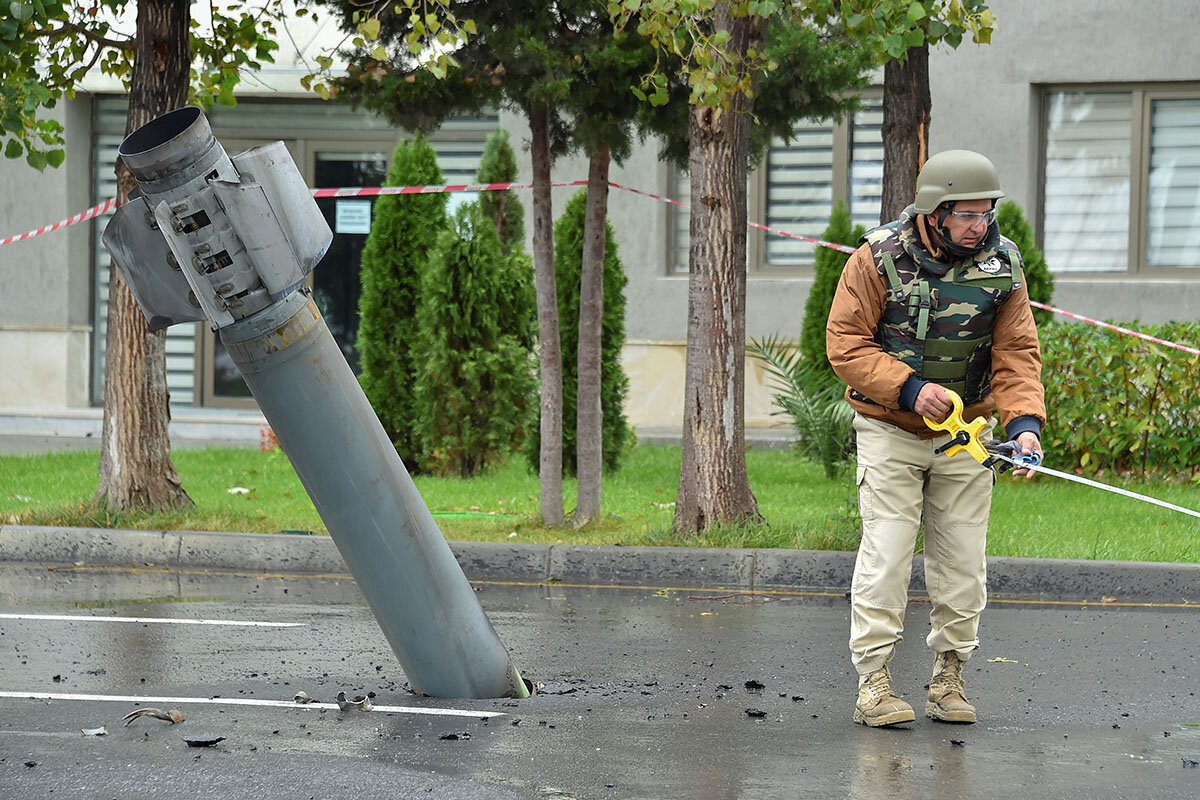
- Quick Read
- Deep Read ( 4 Min. )
The fight over Nagorno-Karabakh was one of a number of territorial and ethnic battles that erupted as the Soviet Union collapsed in the late 1980s. Thousands died. Hundreds of thousands were displaced. The majority Christian Armenian enclave declared independence from Shiite Muslim Azerbaijan in 1991, and rebel forces were able to occupy one-fifth of Azerbaijani territory.
Four United Nations resolutions in 1993 called for Armenia to withdraw. And since the cease-fire in 1994 – which was meant to be temporary – Azerbaijan has vowed to regain the territory, even as neighboring Armenia considers itself Nagorno-Karabakh’s security guarantor.
After lying largely dormant for decades, conflict has escalated in the past week. At least 250 people have been killed, and a largely local ethnic dispute runs the risk of turning into a wider regional war.
The new player in the conflict – viewed by some analysts as a key destabilizing factor – is NATO power Turkey. Its foray into the South Caucasus is its latest regional military intervention, after Syria and Libya. It has vowed to provide unequivocal backing to its close ally Azerbaijan amid a combustible mix of nationalism, rising military capabilities, and energy politics.
Turkey stirring the pot? Why Armenians, Azeris are fighting again.
After lying largely dormant for decades, conflict has escalated in the past week between Azerbaijan and Armenia over the enclave of Nagorno-Karabakh. At least 250 people have been killed, and a largely local ethnic dispute runs the risk of turning into a wider regional war.
As artillery, drone, and rocket attacks increasingly target population centers on both sides, rival leaders have staked out uncompromising positions over the fate of the mountainous ethnic Armenian enclave carved out of Azerbaijani territory.
Nagorno-Karabakh, still recognized as part of Azerbaijan, has exercised self-rule since a fragile cease-fire in 1994 capped six years of war that left 30,000 dead and some 600,000 ethnic Azeris displaced.
After months of rising tensions, open hostilities erupted Sept. 27. Separatist forces in Nagorno-Karabakh say their largest city, Stepanakert, has been heavily bombarded by Azerbaijan since Friday. Several Azeri cities likewise have been targeted in recent days.

Why is a post-Soviet conflict hot again?
The new player in the conflict – viewed by some analysts as a key destabilizing factor – is NATO power Turkey, which has vowed to provide unequivocal backing to its close ally Azerbaijan amid a combustible mix of nationalism, rising military capabilities, and energy politics.
Turkey’s foray into the South Caucasus – long considered Russia’s backyard, because the two key belligerents are both former Soviet republics – is Turkey’s latest regional military intervention, after Syria and Libya. In all three conflicts where Turkey has flexed its regional muscle, it has often found itself on the opposite side from Russia.
The fight over Nagorno-Karabakh was one of a number of territorial and ethnic battles that erupted as the Soviet Union collapsed in the late 1980s. The majority Christian Armenian enclave declared independence from Shiite Muslim Azerbaijan in 1991, and rebel forces were able to occupy one-fifth of Azerbaijani territory.
Four United Nations resolutions in 1993 called for Armenia to withdraw. And since the cease-fire in 1994 – which was meant to be temporary – Azerbaijan has vowed to regain the territory, even as neighboring Armenia considers itself Nagorno-Karabakh’s security guarantor.
Brief clashes erupted in 2016, leaving 200 dead. Fighting erupted again this past July after Armenia killed an Azerbaijani general and several officers. The skirmishes this summer prompted Turkey to send men and military equipment to Azerbaijan for two weeks of joint land and air exercises.
Each side accuses the other of starting the latest fighting, and both have enhanced their military prowess, which experts say is one of several contributing factors in the latest flare-up.
“Both Azerbaijan and Armenia have acquired new military capabilities,” writes Turkish military analyst Metin Gürcan in the online news site Al-Monitor. He also cites “major changes” in energy politics of the South Caucasus that have brought Azerbaijan and Turkey much closer together, with pipelines that bring Azeri oil and gas through Turkey.
In addition, writes Mr. Gürcan, “nationalist and populist trends are on the rise in both Azerbaijan and Armenia, pushing their respective leaders ... to adopt more escalatory postures.”
How has Turkey changed the battlefield equation?
Armenia accuses Turkey of playing a direct role: shooting down an Armenian jet fighter, boosting Azerbaijan’s drone capabilities, deploying 150 Turkish officers, and even recruiting and sending Syrian rebels to the frontline – as Turkey did in Libya.
Ankara denies those accusations. But there is little doubt that Turkey’s presence – and the rhetoric of President Recep Tayyip Erdoğan, who promised again Friday to back “brotherly” Azerbaijan “with all our means and all our heart” – has emboldened Baku.
Indeed, Azerbaijani President Ilham Aliyev on Sunday laid down tough conditions for a cease-fire. Armenian forces “must leave our territories, not in words but in deeds,” recognize the country’s territorial integrity, and apologize.
Mr. Aliyev has trumpeted the recent capture of a string of Karabakh villages. Those gains prompted hundreds of people in Baku to take to the streets, waving flags and signs that read, “Karabakh was and will be ours,” Reuters reported.
The Karabakh presidency warned that it would “expand subsequent [military] actions to the entire territory of Azerbaijan.”
Armenian Prime Minister Nikol Pashinyan cast the current fight in nationalist terms, likening the current battle to Armenia’s war against Ottoman Turkey more than a century ago – a period when the precursor of the modern Turkish state killed at least 800,000 ethnic Armenians in the first genocide of the modern era.
What are the chances of peace?
The scale of renewed fighting indicates that the fragile status quo prevalent for 26 years – with an enclave of Armenian self-rule in the midst of Azerbaijani territory – may no longer be tenable.
The Minsk Group – founded in 1992 to end the conflict, and chaired by France, Russia, and the United States – has called for an end to hostilities. Russia has so far not officially taken sides, for despite having a defense pact with Armenia and a military base there, it has also provided weapons to Azerbaijan.
France has been loudest in calling for a cease-fire and has offered to mediate. Armenia on Friday said it would work toward a cease-fire with the three big powers.
But Turkish Foreign Minister Mevlüt Çavuşoğlu dismissed the request, saying that “superficial demands for an immediate end to hostilities and a permanent cease-fire will not be useful at this time.”


EU, US oil giants take diverging paths on climate
Moves by European energy giants – not yet mirrored by U.S. firms – show what a difference a base of operations, and a values set, can make. We look at both perspectives.

- Quick Read
- Deep Read ( 6 Min. )
BP announced recently that it would cut its fossil fuel production by up to 40% over the next decade. It joins several European oil and gas companies promising drastic reductions in greenhouse gas emissions and steep investments in renewable energy, with a goal of carbon neutrality by 2050.
But this zeal isn’t shared by U.S. oil companies. Far from giving up on hydrocarbons, they are doubling down on efforts to extract oil and gas while pursuing technologies to capture and store carbon emissions.
The result is a bifurcation between U.S. and European companies over the future of a $5 trillion industry.
“There’s never been such a wide disparity in strategy between major oil companies, and it reflects where they live,” says oil historian Daniel Yergin.
Neither path guarantees success. Following the crash of oil prices this year, European fossil fuel companies may not have enough cash on hand to effectively shift to renewables. The U.S. approach relies on technology that has yet to be proven to work at scale.
“To make that pivot [to green energy] takes a lot of investment and a lot of equipment,” Dr. Yergin says. “From that point of view, 2050 is not that far away.”
EU, US oil giants take diverging paths on climate

When BP recently unveiled a strategic makeover for an era of rising alarm over climate change, environmentalists were on guard for greenwashing by a global oil titan.
But BP’s announcement that it would increase its renewable energy assets tenfold – and slash oil and gas output by up to 40% over a decade – gave even its sternest critics reason to cheer. Greenpeace, which in February picketed BP’s London offices with solar panels and oil barrels to protest its climate policy, called it a “credible and encouraging start.”
The British company is one of several European oil and gas companies that have pledged to achieve net-zero carbon emissions by 2050. They are racing to embrace renewable sources of energy for a future of smart grids, electric cars, and digital commerce.
That zeal isn’t shared by U.S. oil companies, though. Far from giving up on hydrocarbons, they are doubling down on them in the belief that demand will be back, even as the deleterious effects of their emissions attenuate. The result is a rift between U.S. and European companies over the future of a $5 trillion industry that powers a world beset by climatic crises.
“There’s never been such a wide disparity in strategy between major oil companies, and it reflects where they live,” says Daniel Yergin, an oil historian and author of a new book, “The New Map: Energy, Climate, and the Clash of Nations.”
In Europe, a “survival strategy”
European governments have set ambitious goals to decarbonize their economies and are asking oil companies, some of which are state-owned, to develop cleaner forms of energy. That political consensus is underpinned by public concern over climate change and environmental degradation; pension funds are also pushing oil companies to account for climate impacts.
“All companies pay attention to their shareholders. But European companies pay attention to their stakeholders,” says Kevin Book, director of research at ClearView Energy Partners, a Washington-based consultancy. “To be a European company is to think about European people and European values.”
This month, the European Commission presented a plan for emissions cuts of 55% by 2030, compared to 1990 levels, a target that would require massive investments in low-carbon energy production. The 27-member European Union aims to be carbon neutral by midcentury. (Britain, which left on Jan. 31, has set the same goal.)
By contrast, the Trump administration has belittled climate scientists, rejected the Paris Agreement on emissions cuts, and rolled back regulations on oil, gas, and coal producers.
Public opinion and government policy aren’t the only reasons why companies like BP, France’s Total, and Royal Dutch Shell are trying to reinvent themselves as clean energy providers. They are also making a virtue out of necessity, having written off billions of dollars in investments after oil prices plunged from nearly $70 a barrel in January to briefly going negative in April.
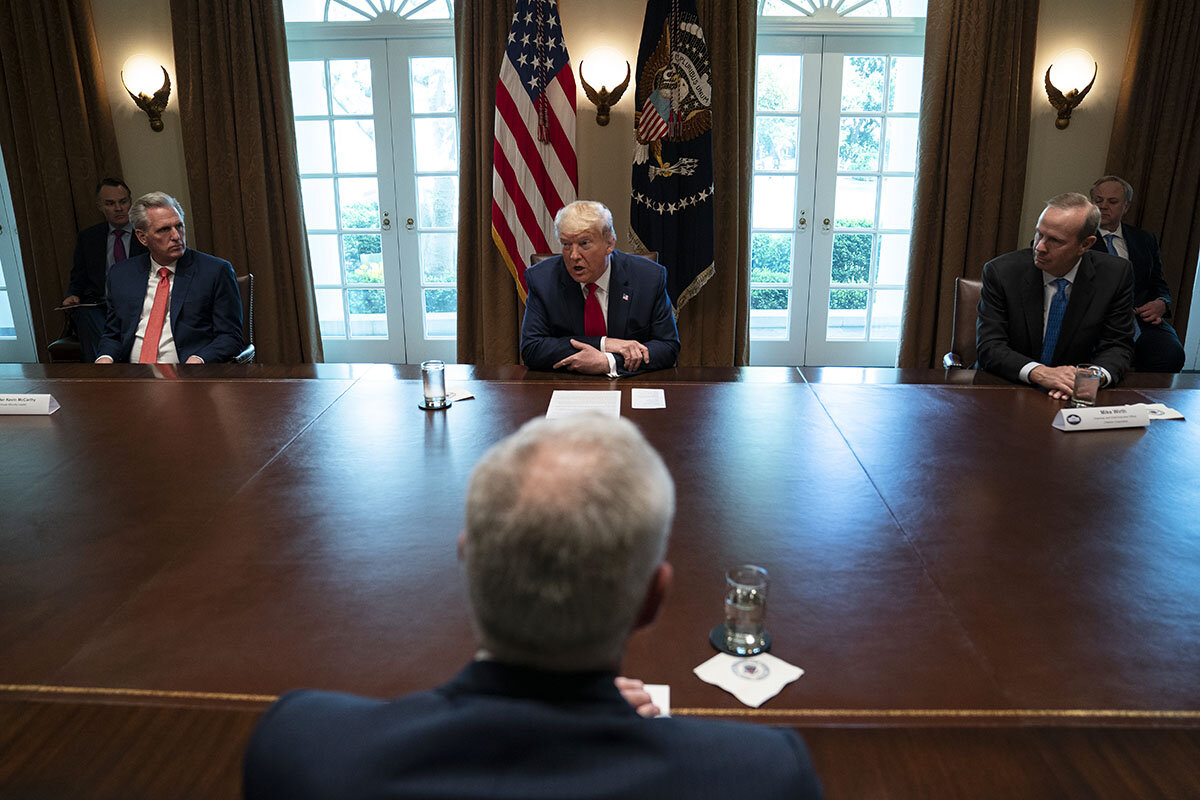
The risk they face going forward is that investors in Europe may see loss-making oil companies as dinosaurs who left it too late to diversify, says David Goldwyn, a former State Department official for international energy affairs. “It’s an economic reality and a survival strategy,” he says.
Cutting the emissions, keeping the oil
That reality looks different in Houston, the U.S. oil capital. Companies like ExxonMobil and Chevron Corp. also anticipate greater scrutiny of their own emissions and that of the products they sell, say analysts. But they’re not about to reinvent a business model that goes back to John Rockefeller and has been reinvigorated by shale production. Instead they will keep drilling and selling oil and gas while investing in new technologies to capture and store carbon.
“For the U.S. majors, the goal is to reduce emissions, not to promote renewables,” says Mr. Goldwyn.
In July, Chevron CEO Mike Wirth assured the Texas Oil & Gas Association that a global transition toward cleaner forms of energy wasn’t an existential threat. “We’ll find ways to make oil and gas more efficient, more environmentally benign,” he said.
Unlike Europe, which imports 75% of its oil, the U.S. has ample domestic reserves. And the vertiginous market crash – prices are now around $40 a barrel – has wiped out smaller players, squeezed speculators, and created opportunities. In July, Chevron agreed to pay $4 billion for Noble Energy, which produces natural gas in Israeli waters in addition to shale assets in the U.S.
Ultimately, the calculus for U.S. oil producers is about cost and efficiency. “There is a view that if they can make this business profitable at as low an oil price as possible, at $30 a barrel, they can survive,” says Atul Arya, chief energy strategist at IHS Markit, a research firm.
That business-as-usual approach could prove risky if a Biden administration prioritizes climate and Congress legislates to put a price on carbon. The former vice president has set a target of net-zero carbon in electricity generation by 2035, the same year that California says it wants to end the sale of new gasoline-powered vehicles. Another risk lies in Europe’s plan to introduce a carbon border tax that could set global standards for trade in goods.
Set against those risks is the near-certainty that the world will need more natural gas, which emits less carbon dioxide than oil but consists mostly of methane, a potent heat-trapping gas. U.S. producers also see upsides in supplying energy-importing countries in Asia and Africa after the pandemic recedes and in being profitable even if crude prices never soar as high again.
“Exxon believes there will be more days of gold and milk and honey. Shell and BP and Total don’t. ... They think we’re moving into an era in which oil and gas will not generate those returns,” says Clark Butler, a corporate adviser in Sydney who studies the industry.
What sets apart multinationals like BP, founded in 1908 as the Anglo-Persian Oil Company, is a global trading mindset, says Mr. Book. While Standard Oil and its descendants competed on world markets, their production hub was the world’s largest economy and their corporate culture was one of engineers. Europe had fewer resources and its oil companies began as traders, a legacy that endures in the commodity trading desks they run today, akin to Wall Street banks.
“It’s easy for them to make this leap,” he says.
“Been there, done that”
The 1973 oil shock spurred U.S. oil companies to invest in alternative energy, including solar panels. The lithium-ion battery on which today’s electric cars depend was invented by Exxon, back when it seemed possible that the world might run out of gasoline.
This time “there’s a sense of been there, done that,” says Dr. Yergin, referring to U.S. oil majors. “They’re also saying, why would it be better for us to be in the electricity business?”
That BP and its peers can succeed in this business is far from certain. They have the advantage of huge retail networks – Shell has 44,000 gas stations around the world that can offer electric vehicle charging – but are entering a regulated sector with lower profit margins than oil and gas during a global recession.
Shell and Total “aren’t pivoting sufficiently towards renewables to hit their [decarbonization] goals at the moment. One of the reasons is that the returns may not be there,” says Mr. Butler.
Shell recently cut its dividend for the first time since World War II. BP also faces a cash crunch that could complicate its green makeover, says Mr. Arya, a former BP executive who was its chief adviser on climate and energy policy. “In an ideal world, you have a high oil price and you take those profits and invest aggressively in renewables,” he says.
A transition to cleaner forms of energy is as much about technology as corporate strategy since many of the pathways to decarbonization, such as carbon capture at power plants, are unproven at scale and fossil fuels still provide 84% of the world’s energy, says Dr. Yergin.
“To make that pivot [to green energy] takes a lot of investment and a lot of equipment. From that point of view, 2050 is not that far away,” he says.

Can India’s tea gardens be a haven for wild elephants?
This report from India highlights one solution to a human-wildlife clash. It involves shifting from a mindset of conflict to one of coexistence.

- Quick Read
- Deep Read ( 5 Min. )
-
By Kalpana Sunder Correspondent
India’s northeastern state of Assam is known worldwide for its plantations that produce subtly flavored breakfast teas. The state is also home to nearly 6,000 Asian elephants.
Unfortunately, interactions between these two Indian icons often end in tragedy. Tea workers are frequently trampled. Elephant calves often die after falling in drainage ditches.
“Very often the elephants would destroy fences, uproot trees, and terrorize the employees,” says Tenzing Bodosa, who operates two tea gardens in Assam with more than 70 workers. “That was when I got the idea that there must be a way to coexist peacefully.”
To promote coexistence, Mr. Bodosa created elephant-friendly buffer zones on his farms, replete with elephant grass, elephant apples, bamboo, and star fruit. He also provides the elephants with water and a transit corridor free of ditches and barriers.
His efforts earned him certification from the Certified Elephant Friendly Tea Program, a partnership between the Wildlife Friendly Enterprise Network and the University of Montana.
To proponents, the voluntary certification program offers an opportunity for animal-loving consumers to make their voice heard. “[It] can allow consumers to vote with their wallets on issues that are important to them,” says Julie Stein, executive director and co-founder of WFEN.
Can India’s tea gardens be a haven for wild elephants?
It was a full moon. Tenzing Bodosa awoke, disturbed by a sound in his tea gardens. Looking out of his porch he saw a herd of wild elephants under the silvery light, with the calves frolicking, the mother munching on the luxuriant grass, and the male elephant standing guard.
For many tea farmers in India, seeing a herd of wild elephants amid the crops is cause for alarm. But for Mr. Bodosa, who employs more than 70 workers at two farms in Assam’s Udalguri district, it meant everything was working just as he planned.
His operations, which he calls the “world’s first elephant-friendly tea farm,” were certified in 2016 by the Certified Elephant Friendly Tea Program, a partnership between the Wildlife Friendly Enterprise Network (WFEN) and the University of Montana.
“Certification can come about in different ways,” says Julie Stein, executive director and co-founder of WFEN. “Sometimes we become aware of exemplary farmers who are thought leaders, sometimes tea growers reach out to us to see if they qualify, sometimes tea brands may contact us to see if their suppliers qualify.”
Ms. Stein says the program conducts a full field audit before certification. Consumers pay a premium for this tea, which is sourced from plantations that protect elephant habitats, reduce barriers and ditches to facilitate the easy movement of elephants, and ensure safe disposal of chemicals.
“A voluntary certification program like ours can allow consumers to vote with their wallets on issues that are important to them,” Ms. Stein says.
A species in peril
The IUCN Red List classifies Asian elephants as an endangered species, with about 40,000 to 50,000 remaining across their range countries, a decline of more than 50% in the last 75 years. According to Sandeep Tiwari, program manager of the IUCN’s Asian Elephant Specialist Group, India is home to about 28,000 wild elephants. “Many reasons have led to this,” he says, “from fragmentation, degradation, and loss of habitat to poisoning, electrocution, poaching, and elephant-man conflict.”
One of the surprising reasons for the declining population is connected to tea cultivation. India is the second-largest tea grower after China, and Assam leads tea production. Assam has a population of 5,719 wild elephants, the most after the state of Karnataka. Elephants perceive tea gardens as extensions of their forest habitat, as they have been part of their migratory routes over centuries. They quite often use them to rest in the daytime, to eat food and drink water, and to give birth.
In India, interactions between humans and wild elephants often end badly for members of both species. Elephants kill more than 400 people – many of them tea garden workers – in the country each year. Sometimes, due to lack of natural forage, elephants enter villages to raid crops, and villagers pelt them with stones or hit them with sticks to drive them out. Many calves are trapped in the ditches that are dug for drainage in tea estates.
Most tea plantations date back to British colonial times, when government wastelands were given on lease to tea companies. In Assam, home to most of India’s tea plantations, elephant corridors are shrinking.
“Very often the elephants would destroy fences, uproot trees, and terrorize the employees,” says Mr. Bodosa. “That was when I got the idea that there must be a way to coexist peacefully.”
Mr. Bodosa has been growing tea organically since 2007, when he was one of the few farmers using natural products like cow manure, bone meal, and urine. He realized that using artificial fertilizers and pesticides was not only harmful to those farming but also to the final product. “I thought that something that people start their day with, a cup of tea, can’t be full of poison,” he says.
Mr. Bodosa picked up the nuts and bolts of organic farming from a Canadian nongovernmental organization, and later Dr. L Narayana Reddy, an organic farmer in Bengaluru who taught him composting. Mr. Bodosa planted plants and trees like litchi, guava, and jackfruit; used local leaves as pesticides; and brought about an ecological balance on his farm.
To make his farms elephant-friendly, he created a buffer zone for them, planting it with vegetation that the elephants are fond of, from elephant grass and elephant apples to bamboo and star fruit; made a tank with stored water; and provided them easy passage by making sure there were no ditches, fences, or barriers. Hornbills, mongooses, peacocks, and deer frequent his tea gardens. Many human visitors come to his farms, and even stay in a treehouse that he has built, and volunteer.
Mr. Bodosa has also trained as many as 70,000 farmers from neighboring states like Sikkim, Nagaland, and Arunachal Pradesh in organic farming. WFEN and the University of Montana have funded a reforestation project here, where women grow native trees and schoolchildren help plant trees for elephant habitats.

Securing a “lasting peace”
The 1,200 acre Nuxalbari Tea Estate in Darjeeling, established in 1884 and run by fifth-generation owner Sonia Jabbar, was the first large tea estate to be certified elephant-friendly, though Ms. Jabbar has since opted out of the program.
The estate, which lies in the middle of an elephant corridor, has been working for years to help wild elephants in the area. Actions include creating elephant pools; planting native trees, shrubs, and grasses so that elephants have shelter and forage; implementing an early warning system for workers; and training estate security to keep elephant corridors free. Nuxalbari also has a club for workers’ children, educating them through games and films on conservation and climate change. Last year, Ms. Jabbar was awarded the Nari Shakti Puraskar, India’s highest civilian award for women.
Recently, she created the Hathi Sathi Foundation, which scales up the work at Nuxalbari Tea Estates to other tea estates and villages across north Bengal. “Human-elephant conflict is a colossal issue in these parts,” she says. “Now with a grassroots organization that focuses solely on conservation, we hope to bring lasting peace between humans and our majestic elephants.”
“We have to work hard to secure the lives of both wild elephants and humans,” she says.

Books
100 years on, it’s no mystery why Agatha Christie’s stories endure
What makes a writer’s work persist and influence novelists who follow? In the case of Agatha Christie, it’s not just twisting plots. It’s also a sense of justice and compassion for human foibles.
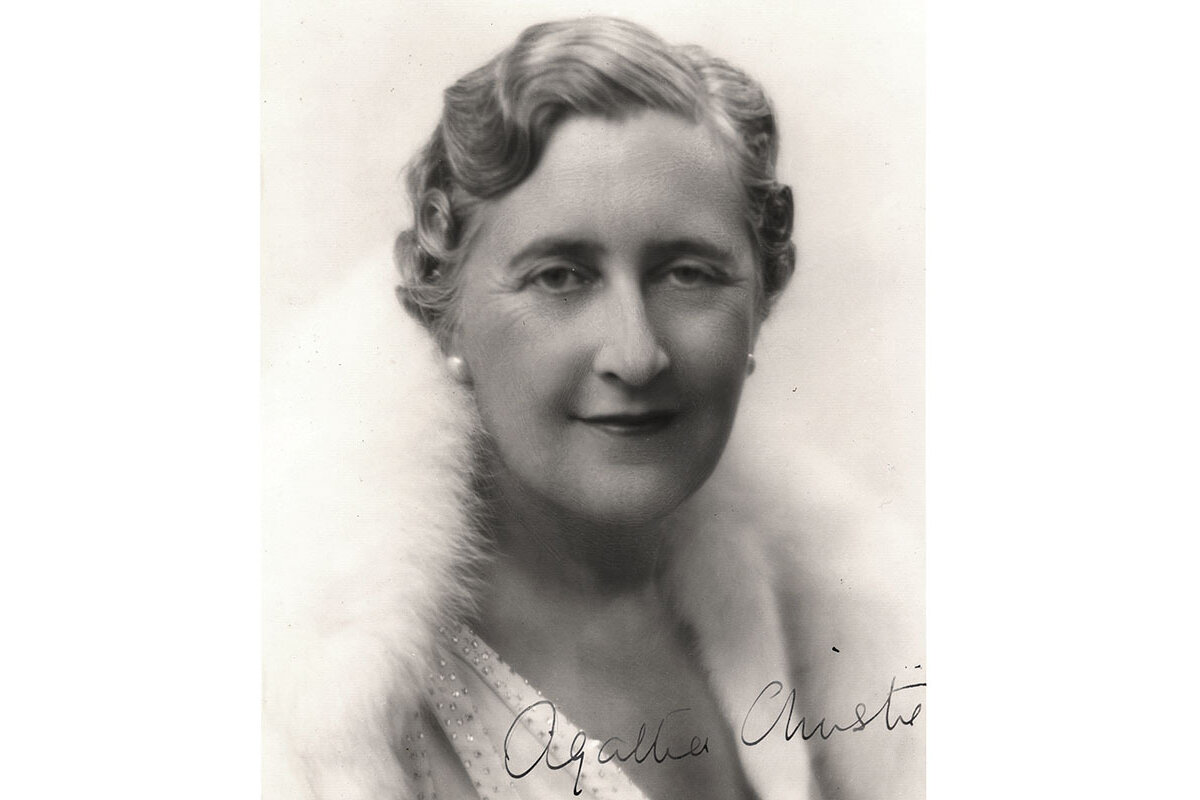
- Quick Read
- Deep Read ( 5 Min. )
One hundred years since her debut novel, “The Mysterious Affair at Styles,” why does Agatha Christie’s work remain popular? Why have the sales of her books – $2 billion worth – only been surpassed by the Bible and Shakespeare’s works?
To answer those questions, it’s wise to heed the wisdom of one of her most popular characters, Hercule Poirot: “The simplest explanation is always the most likely.” Readers love her intricately plotted mysteries because they unfurl like astonishing magic tricks. But Christie’s admirers say that reducing her stories to mere puzzles is to miss the beating heart of her writing. The mysteries wouldn’t work if we didn’t believe the motives for the crimes.
“Christie has a genius for distilling complicated human behavior down into its essence,” says Kate Stine, editor of Mystery Scene magazine and a former director of the Agatha Christie Society, in an email. “She had very firm ideas of right and wrong and while her characters might do pretty much anything, their sins always caught up with them in some fashion.”
100 years on, it’s no mystery why Agatha Christie’s stories endure
For years, the English village of St. Mary Mead has been the unlikely murder capital of the world. The literary world, that is. Agatha Christie’s fictional hamlet – the home of amateur sleuth Jane Marple – has seen its unfair share of murders, including at the vicarage.
Last year, 4 million people purchased books written by Christie, known as the Queen of Mystery, to visit the bucolic worlds within her pages. They came to peer into the parlors of country estates where her beloved detectives, Hercule Poirot and Miss Marple, solve seemingly impossible cases.
Yet there’s still one Christie mystery that remains unsolved. One hundred years since her debut novel, “The Mysterious Affair at Styles,” why does her work remain enduringly popular? Her $2 billion sales lag behind only Shakespeare and the Bible.
To answer that question, perhaps it’s wise to heed the wisdom of Monsieur Poirot: “The simplest explanation is always the most likely.” Readers apparently love her intricately plotted mysteries because they unfurl like astonishing magic tricks in which the illusionist always shows how she did it. But Christie’s admirers say that reducing her stories to mere puzzles is to miss the beating heart of her writing. The mysteries wouldn’t work if we didn’t believe the motives for the murders. Her keen observations about people’s virtues and vices, rooted in a deep sense of justice, have enabled her books to flourish beyond the era in which they were written.
“Christie has a genius for distilling complicated human behavior down into its essence,” says Kate Stine, editor of Mystery Scene magazine and a former director of the Agatha Christie Society, in an email. “She had very firm ideas of right and wrong and while her characters might do pretty much anything, their sins always caught up with them in some fashion.”
Those qualities have made her 66 crime novels lucrative properties for television and cinema adaptations. In the imminent movie “Death on the Nile,” Kenneth Branagh reprises the role of Poirot from his 2017 film “Murder on the Orient Express.” (His dubious mustache has the wingspan of an albatross.)
Meanwhile, the Belgian detective has been resurrected on the page in a new book series by Sophie Hannah, including the just-released “The Killings at Kingfisher Hill.” Countless crime writers – including Ms. Hannah, David Baldacci, and Gillian Flynn – cite Christie as a formative influence. “It was like nothing I’d read before,” says Gilly Macmillan, author of “What She Knew” and “To Tell You the Truth,” who started reading Christie around age 11. “‘The Murder of Roger Ackroyd’ and the twist absolutely blew me away at the end of that one. It was the first book I read where I realized that the author could withhold something so crucial from you and just slam it down at the end.”
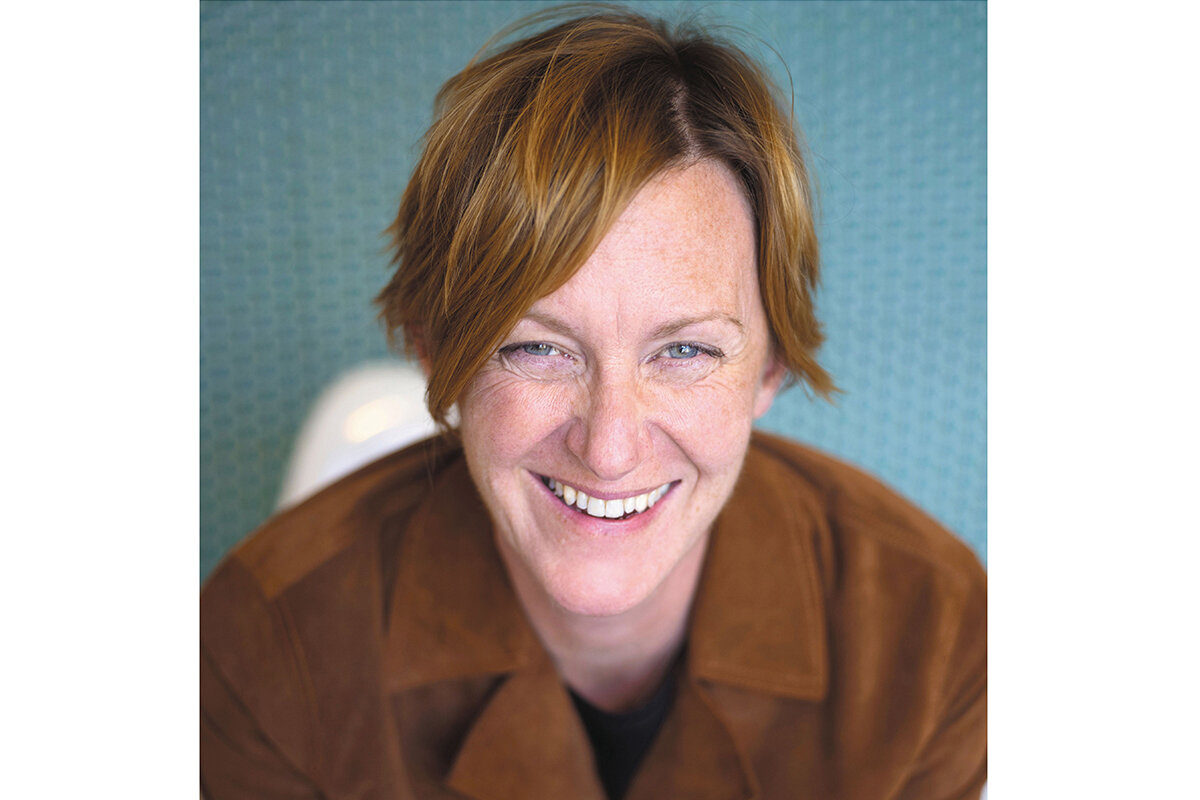
Christie’s detractors grant that her plotting is akin to watching Garry Kasparov play three-dimensional chess. But they complain that her characters are little more than cardboard cutouts. Moreover, her novels revolve around the sort of upper-class figures who fret that the dying tradition of afternoon teatime portends the doom of civilization. On the other hand, Christie’s defenders commend her crisp style, enlivened by wry wit, as she created archetypes that we all recognize. When Lucy Foley wrote her mystery “The Hunting Party,” her array of suspects was inspired by Christie’s diverse casts of characters.
“One thing that actually happened when I was writing is that the identity of the murderer changed,” says Ms. Foley. “I would have assumed that that would never happen to Agatha Christie, because she would have known right from the outset. But apparently something that she often did was wait to decide the identity of the murderer later.”

Although Christie introduced the oddities and frailties of her detectives, they remain fairly inscrutable – much like their famously private creator. In the case of Miss Marple (whose hobbies include knitting and “human nature”) it’s precisely her seeming frailty that makes others underestimate her intelligence. Similarly, readers know very little about the inner life of the fastidious Poirot, whose inclination to tidy and order other people’s rooms would drive even Marie Kondo nuts.
“The Poirots and the Marples of the world are ‘the instruments of God’ to ensure that justice is done, or seen to be done, on earth as it is in heaven,” says Gillian Gill, author of the biography “Agatha Christie: The Woman and Her Mysteries.” “It’s not civil law. It’s not justice in an institutional manner. It is a weighing of right and wrong.”
Ruth Ware, whose latest novel “One by One” has been acclaimed as an homage to Christie’s “And Then There Were None,” also picked up on how the author grappled with what justice really is.
“In one famous example, Poirot colludes in providing the police with a false version of what actually happened, because he agrees that the truth would help no one. In general, though, Christie is not a great believer in extenuating circumstances; motives are very rarely treated as excuses,” writes Ms. Ware via email. “In one of the few examples of her work where a murderer does get away with his crime, Christie herself was so dissatisfied with the ending that she went back and changed it.”

The Queen of Mystery’s books end with a surprise denouement, the unmasking of one of the seven deadly sins at the root of the crime, and the arrest of the guilty person.
“It seems to me that Christie is more understanding than judgmental – this goes back to her understanding of human nature and her ability to empathize with her characters,” says Christopher Huang, author of “A Gentleman’s Murder,” via email. “It was, I think, a way of embracing all of humanity, and it made her characters that much richer, that much more believable, and that much more relatable.”
Other headline stories we’re watching
(Get live updates throughout the day.)The Monitor's View
The pandemic’s bloom of startups
- Quick Read
- Deep Read ( 2 Min. )
-
By the Monitor's Editorial Board
In a little-known challenge to the economic fallout of the pandemic, millions of people have turned the crisis into an opportunity for progress. That is especially true in the United States. According to the Census Bureau, new businesses are springing up at the fastest rate in more than a decade.
Some people can obtain loans, but many start with their own savings, driven by the passion of a good idea to invest in a new service or product. They tap into unexplored creativity, flexibility, and adaptability. One reason many of these new businesses are enjoying early success is that customers crave in-person buying experiences after long periods of social isolation.
Starting a new venture can be scary. But it can also be liberating. People find they must draw on their innate qualities, such as a humility to serve or the courage to test a new idea. Those are the fuel behind any new venture and are just one of the salves during the pandemic.
The pandemic’s bloom of startups

In a little-known challenge to the economic fallout of the pandemic, millions of people have turned the crisis into an opportunity for progress. That is especially true in the United States. According to the Census Bureau, new businesses are springing up at the fastest rate in more than a decade. So far in 2020, the bureau has received more than 3.2 million applications for employer identification numbers. The comparable figure for the same period last year was 2.7 million.
Faced with furloughs or layoffs, many people are fashioning their own form of work. They see the pandemic as a now-or-never time to pursue a dream. (See related story, here.) Choose your cliché to explain this burst of entrepreneurship: Necessity is the mother of invention. Sweet are the uses of adversity. If life gives you lemons...
Some people can obtain loans, but many start with their own savings, driven by the passion of a good idea to invest in a new service or product. They tap into unexplored creativity, flexibility, and adaptability. “The most important lesson of COVID-19 is learning to adapt,” Myriam Simpierre, who opened a neighborhood grocery in New York City, told MarketWatch. “Distribution channels go awry. Prices change. A pandemic happens. Anything can happen. You have to be adaptable.”
Another entrepreneur who opened a hair salon makes sure she regularly sweeps the sidewalk out front and provides a bowl of water for passing canines, giving her an opportunity to “talk to everybody” passing by. In turn, she says, the neighborhood has embraced her business.
While many existing businesses have been forced to shut down, optimistic newcomers push ahead, in part out of a joy in being their own boss. The pandemic has produced a supercharged version of “creative destruction,” the theory that a good economy thrives when older businesses lose their way and innovative ones spot an opening. That churn is also putting the lie to the idea that only big corporations will survive the pandemic.
One reason many of these new businesses are enjoying early success is that customers crave in-person buying experiences after long periods of social isolation. That’s especially true when customers can meet new people, such as in a cafe. Other entrepreneurs spot new trends – such as a strong demand for bicycles – that they can supply.
A personal trainer in Madison, Wisconsin, who lost his job, started a mobile bicycle repair business, investing about $1,000 in equipment. Now he’s booked fixing bikes at people’s homes all day long, earning more than he did in his previous job.
“It feels like I built a rocket and lit it – and now I’m just holding on to the tail,” he told The Wall Street Journal.
Starting a new venture can be scary. But it can also be liberating. People find they must draw on their innate qualities, such as a humility to serve or the courage to test a new idea. Those are the fuel behind any new venture and are just one of the salves during the pandemic.

A Christian Science Perspective
Each weekday, the Monitor includes one clearly labeled religious article offering spiritual insight on contemporary issues, including the news. The publication – in its various forms – is produced for anyone who cares about the progress of the human endeavor around the world and seeks news reported with compassion, intelligence, and an essentially constructive lens. For many, that caring has religious roots. For many, it does not. The Monitor has always embraced both audiences. The Monitor is owned by a church – The First Church of Christ, Scientist, in Boston – whose founder was concerned with both the state of the world and the quality of available news.
Lessons in true compassion
- Quick Read
- Read or Listen ( 4 Min. )
-
By Gabriela Mejía
If we’re feeling wearied by the push and pull of current events, political or otherwise, a spiritual perspective on what it means to be compassionate can uplift the way we react to news and to others who think differently than we do.
Lessons in true compassion
A couple of years ago, I felt the need to explore the meaning of compassion more deeply. I’d been feeling exhausted by the constant push and pull of the political situation in the world. I noticed how easily I felt overcome by deep emotions when reading the news – a great sense of sadness and heaviness regarding those suffering from injustices and other heart-wrenching issues.
I thought I was being compassionate by feeling this way, but it didn’t seem to be yielding much comfort and didn’t feel like a contribution to healing, so I decided to look to the Bible and “Science and Health with Key to the Scriptures” by Mary Baker Eddy for fresh inspiration.
While reading about the children of Israel in the book of Exodus and their long journey from Egypt to the Promised Land, I found it surprising how often the Israelites would doubt God’s power and care for them. What was even more surprising, albeit comforting, was how God never left their side. Time after time, despite all the doubt and complaints from the Israelites, God demonstrated His great patience and love by providing for them and protecting them from harm. My heart warmed even more when I found this passage in Psalms: “But he [God], being full of compassion, forgave their iniquity” (78:38).
I wanted to understand more of that compassion that loves and forgives. Through my study of Christian Science I’d had the opportunity to feel God’s all-embracing and constant love for me, so it made sense that God, who is Love itself, would be full of tender, pure love for all His children. Love had guided the Israelites, provided them food in the desert, and forgiven their trespasses as they turned more Godward. It was because of God’s unwavering, patient love that the children of Israel did eventually come to obey, trust, and love God’s guidance.
I concluded that I, too, in my true identity as a complete and perfect idea of God, could express this pure and forgiving love toward everyone around me. I could have no traits of unloving judgment, self-righteousness, or ill will, because they are not qualities of God. Of course, if this was true about me, in reality it had to be true about everyone else.
Another point I wanted to clarify in my thought was whether it was really true that in order to be compassionate one has to feel sorrow for others’ troubles. This was essentially what I had often found myself doing when reading the news. But in Science and Health, Mrs. Eddy, quoting from the Bible, makes it clear that “God is ‘of purer eyes than to behold evil’” (p. 357). This means that God could not see His children as lacking, suffering mortals and then feel sorrow for them. On the contrary, God sees and has always seen everyone as perfect, complete, and satisfied. In other words, He sees each of us as He created us, in His image and likeness.
I realized that being truly compassionate entails embracing everyone in thought as God’s perfect and loved child and recognizing, without hesitation, that no one could actually ever be outside of His all-encompassing love. And because God is Love and man reflects God, we really can’t help expressing compassionate, healing love.
Another thought that came to me was that true compassion is not a passive quality. It is not just a superficial thing to feel compassion toward another, but it is powerful and can contribute to healing. Christ Jesus was often described as being “moved with compassion” when the multitudes approached him seeking healing (for example, in Matthew 14:14). His healing ability never failed because he knew it came from God. And we can all naturally follow his example by opening up to God’s grace and love and witnessing healing.
I also realized that expressing compassion is one of the most selfless gifts one can give another, because it requires letting go of a personal sense of ego or self. It helps one turn from a me-focused mentality to the selfless desire to genuinely care about the welfare of another.
These insights have been very important in helping me improve the way I react to the news and to others who think differently than I do. I am constantly comforted to know that God is our source of compassion and that each of us can not only feel compassion toward others but see it lead to healing as well.
Adapted from an article published in the Oct. 2019 issue of The Christian Science Journal.

A message of love
Force meets flowers in Belarus
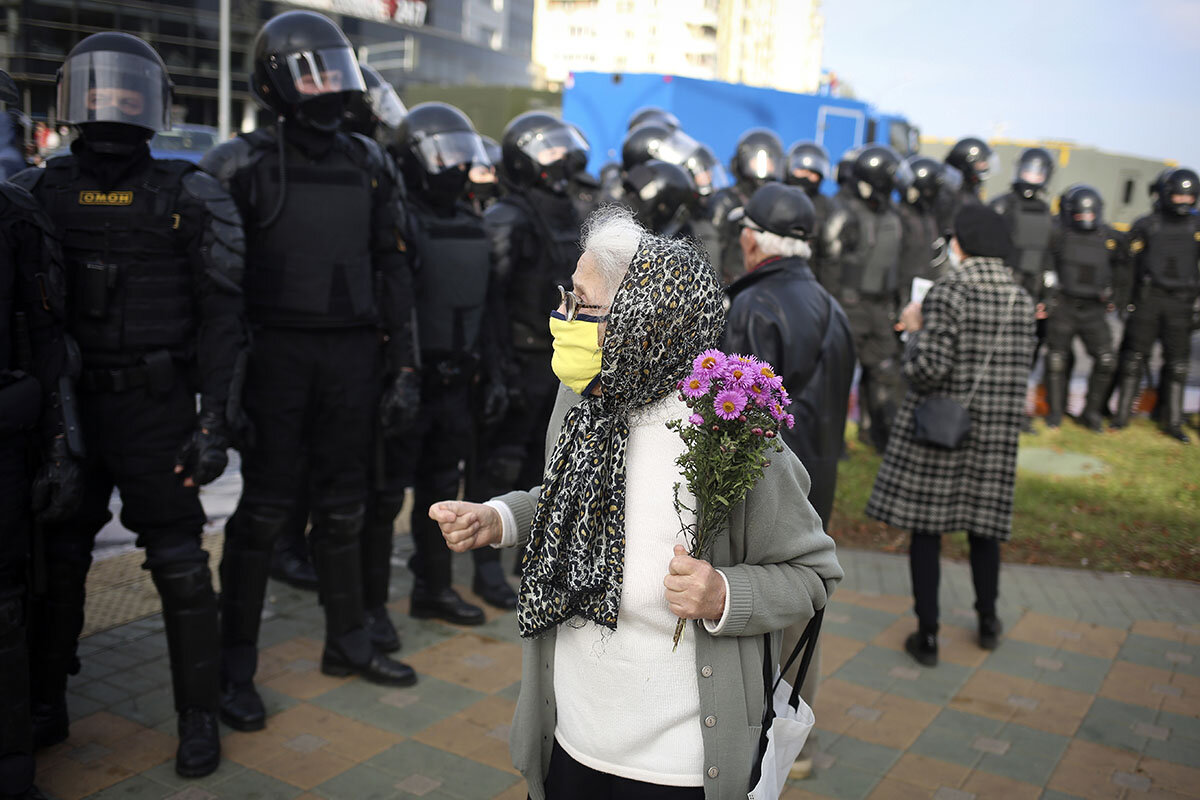
A look ahead
Thanks for starting your week with us. Tomorrow our Supreme Court watcher will look at the president’s promise to appoint reliably conservative judges and what that could mean for increasingly empowered conservative Christian legal organizations – and for American law and society.



